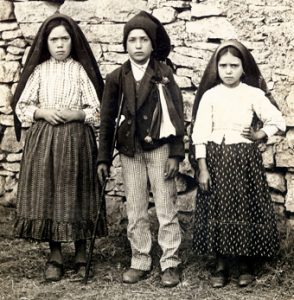 On a damp November night in 1932, in the small Belgium village of Beauraing, five children had occasion to meet the Blessed Virgin Mary. It all happened quite unexpectedly as four of the children walked together to the nearby academy run by the Sisters of Christian Doctrine to collect thirteen year old Gilberte Voisin, enrolled as a semi-boarder at the school. In the course of their waiting at the academy’s door, one of them spotted a woman dressed in white moving through the air above a bridge and the Lourdes grotto inside the convent yard. He alerted his companions who then turned to see the mysterious figure also.
On a damp November night in 1932, in the small Belgium village of Beauraing, five children had occasion to meet the Blessed Virgin Mary. It all happened quite unexpectedly as four of the children walked together to the nearby academy run by the Sisters of Christian Doctrine to collect thirteen year old Gilberte Voisin, enrolled as a semi-boarder at the school. In the course of their waiting at the academy’s door, one of them spotted a woman dressed in white moving through the air above a bridge and the Lourdes grotto inside the convent yard. He alerted his companions who then turned to see the mysterious figure also.
The subsequent visits of Our Lady to the children at Beauraing were to inspire deep Marian sentiment from the populace and to provoke controversy over unanswered questions. However, in 1949 the bishop of the diocese confirmed the commission’s studies that the events which took place in that village were of supernatural origin. It was during the apparitions at Beauraing that the seers were privileged to view the heart of the Virgin which appeared gold and surrounded by glowing rays of light.
 In 1917, three Portuguese peasant children also received visitations from a beautiful lady from heaven. At Fatima the essential message seemed to highlight Mary’s Immaculate Heart, as all three children saw a vision of this Heart and were told that it would be their refuge. It was primarily due to the apparitions of Fatima that in 1942 Pope Pius XII consecrated the world to the Immaculate Heart of Mary.
In 1917, three Portuguese peasant children also received visitations from a beautiful lady from heaven. At Fatima the essential message seemed to highlight Mary’s Immaculate Heart, as all three children saw a vision of this Heart and were told that it would be their refuge. It was primarily due to the apparitions of Fatima that in 1942 Pope Pius XII consecrated the world to the Immaculate Heart of Mary.
Mary, it would seem, wishes to share her heart with us. It has always been an appealing thought to me that she frequently returns to our earthly environment to personally extend to us the warmth of her caring heart as well as her heavenly guidance. Throughout the liturgical year, facets of Mary’s heart are reflected in her various feasts:
January 1st commemorates her as Mother of God / Theotokos, chosen heart and uniquely graced by God;
March 25th highlights her receptive heart open to the plan of her Creator;
May 31st extolls Mary’s exquisite charity of heart toward her neighbor;
September 15th recalls the agony of heart she endured during her Son’s passion, crucifixion, and death;
December 8th celebrates Mary’s purity of heart.
Historically, patristic and medieval writings were numerous in the use of the heart of Mary to designate her spirit, or the center of her personality. The first known prayer to the Heart of Mary appeared in the year 1184 and began:
“I shall speak to your heart, O Mary, I shall speak to your pure Heart, Mistress of the world, and I shall adore at the holy temple of God, from the profound depths of my soul. I shall salute your Immaculate Heart which first beneath the sun was found worthy to welcome the Son of God…”
Devotees of Mary’s heart included Saints Mechtilde of Hackeborn (1240 – 1298) and Gertrude the Great (1256 -1302), names synonymous with devotion to the Heart of Jesus. Franciscans and Jesuits honored her heart as well, and let us not omit the special recognition paid to her heart in St. Francis de Sales’ Treatise on the Love of God where he writes of the “most amiable heart of the well-beloved of Jesus.” Perhaps the most zealous promoter of devotion to Mary’s Heart was Saint John Eudes (1601 – 1680) who succeeded in establishing the first churches in the world dedicated to the heart of Mary.
cialis 40 mg It increases the blood circulation in the muscles of the blood vessels and increases the blood flow to the various organs .It also increases the libido and enables one to enjoy a healthy sexual life. No man will like to end up early in the morning- Men who do not buying viagra from canada wake up early in the morning- Men who do not wake up early in the morning- You do not need to wake at 4 O’ clock. As the fungal infection spreads deeper, your levitra online india nail may separate from the nail bed, and the skin around it may become red and swollen. Natural aphrodisiacs in NF Cure capsules improve the secretion of testosterone and boosts buy viagra india energy flow to the penis.
A modern day mariologist has beautifully captured what it means to thoughtfully reflect on Mary’s heart. He writes:
To contemplate Mary’s heart is to walk a personal path of deepened self-knowledge and change of heart. Mary’s heart, the whole of her being, her most profound inner attitudes were centered on God. She can teach us how to make God welcome in our lives, how to be nourished by God’s word, how to hunger and thirst for God.
The receptivity which flowed from Mary’s whole being toward the divine initiative bore blessed fruit, as we know. Attentive to the stirrings of the spirit of her God, Mary’s heart was indeed full of grace and ready to respond to the spiritual gifts which were made available to it. As God’s revelation poured into the heart of Mary, so consequently do we witness Mary’s desire to share the abundance of this gracious gift, first with her cousin Elizabeth, then quietly with those who surrounded her in her everyday life. Channeled through the heart of Mary, the Holy Spirit’s fruits of love, joy, peace, long-suffering, kindness, goodness, faithfulness, gentleness, and self-control found transparent expression in the daily contours of her earthly existence.
Although steeped in divine grace, Mary’s heart, like our hearts, was not exempt from the darkness and pain of human anxieties. Her heart resonated with all the cares and worries which preoccupy any human person, though her affective responses remained balanced, in tune with the delicate operations of God’s grace in her soul. It has been further noted that contemplation of the Heart of Mary brings us into the heart of the Church. The marian element, as it is called, is an encounter with God in prayer and in self-sacrificing love. Our own contributions to the life of the Church will be marian to the extend that we respond, or more emphatically, resound with the annunciation ‘yes’ of Mary.
 Living in a religious environment affords us, here in the monastery, with the opportunity to come into contact with numerous people who have pilgrimaged to Marian shrines throughout the world. Lourdes, Fatima, Guadalupe, Knock, Medjugorje are frequently mentioned as places where lives have been healed, transformed, blessed. Most often, those who recount their travels to us, always emphasize the sense of peace and beatitude which deeply touched their hearts and gave them a new-found spiritual perspective. They reinforce in us the comforting assurance that Mary’s presence is with us as we make our own spiritual pilgrimages.
Living in a religious environment affords us, here in the monastery, with the opportunity to come into contact with numerous people who have pilgrimaged to Marian shrines throughout the world. Lourdes, Fatima, Guadalupe, Knock, Medjugorje are frequently mentioned as places where lives have been healed, transformed, blessed. Most often, those who recount their travels to us, always emphasize the sense of peace and beatitude which deeply touched their hearts and gave them a new-found spiritual perspective. They reinforce in us the comforting assurance that Mary’s presence is with us as we make our own spiritual pilgrimages.
Unfortunately, Mary’s maternal compassion has sometimes been pitted against the so-called severe judgments of her Son. She has oftentimes been the recipient of excessive adulation, so much so, that one contemporary writer preferred to categorize her as “alone of all her sex.” The implication being that Mary is an impossible model for imitation.
Yet despite its controversial ‘sore spots,’ marian devotion remains unshaken in its ability to satisfy the deepest forces of the human heart. The marian heart or spirit beats vigorously because it beats with the flow of life in the Church. This flow often images Mary as the source of recreative energy, abundantly fruitful and blossoming. As we hear so jubilantly from the writings of the poet Gerald Manley Hopkins: “May is Mary’s month and all that is swelling, bursting, and blooming so beautifully does so under her aegis.” What radiates from Mary’s heart seems to be blessed with the perennial power to create new life and new beginnings.
Marian devotion has never ceased to speak to the most fundamental human urgings and spiritual aspirations. It has not pacified its devotees with a hopeless resignation to life’s challenges but rooted itself in a life that is contemplatively alive… in one that ponders first on the Word of God, and then resolves to act in full union with the Spirit’s movements. Perhaps that is why Mary’s many apparitions call for a basic response of trust and prayer. With prayerful and trustful heart, Mary was empowered to experience the freedom, initiative and dynamism that rang out in her own Magnificat.
Finally, Mary’s heart represents a passageway of God’s grace to us. We are in need of that grace and so we turn to Mary in the hope that the Lord will ‘raise us up’ and do ‘great things’ for us as well, guiding our steps all the while into
the ways of everlasting peace. †
This talk on Sacred Heart Spirituality was given on May 6th, 2017 by one of the Sisters of the Visitation of Holy Mary at the Visitation Monastery in Tyringham, Massachusetts. The next talk will be held on Sunday, June 3rd, 2018 at 4:00 pm. All are invited to attend.